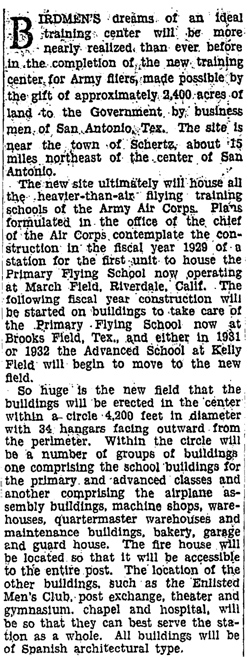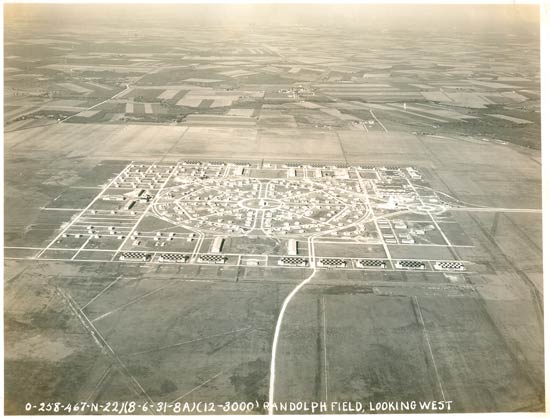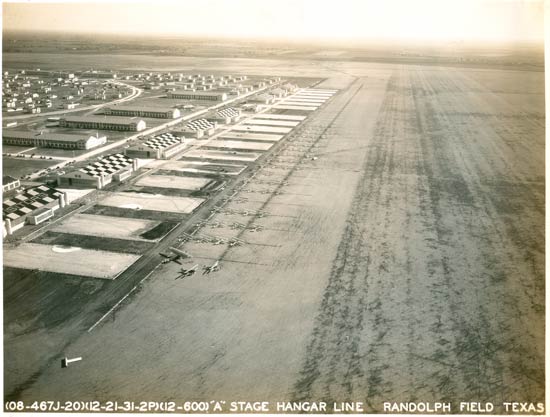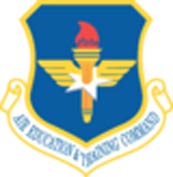Washington Post, April 29, 1928
 |
Randolph Field was named after Register pilot Captain William Millican Randolph, who crashed his Army Curtiss Hawk on takeoff from Gorman Field, TX, February 17, 1928. Capt. Randolph landed at Tucson Tuesday, October 4, 1927, about 4.5 months before his death.
Once the committment was made to establish an airfield near San Antonio, TX it didn't take long for it to be built. The Washington Post of April 29,1928, left, describes the gift of 2,400 acres of land for the airfield. The original design and geometry of the field were followed closely. A little over a year later the airfield was in operation.
Randolph Field was dedicated June 20, 1930. There are numerous history links, for example here. Today the 397 buildings of the old core area of the original field comprise a National Historic Site.
Later in the 1930s, as war developed in Europe and the Pacific, Randolph Field was a busy and rigorous basic training ground for Army pilots. Starting in the spring of 1939, primary training was delivered at nine civilian centers designated and certified by the Army to deliver primary flight training.
These primary training centers were Parks Air College, East St. Louis, IL, the Chicago School of Aeronautics, Glenview, IL, Spartan School of Aeronautics, Tulsa, OK, Grand Central Flying School, Glendale, CA, Santa Maria School of Flying, Santa Maria, CA, Ryan School of Aeronautics, San Diego, CA, Alabama Institute of Aeronautics, Tuscaloosa, AL, Dallas School and Air College, Dallas, TX and the Lincoln Airplane and Flying School, Lincoln, NB.
Popular Aviation (PA) magazine, October, 1939, published an article that documented what it was like to pass through the primary and then the basic pilot training program at Randolph. The article, "9 Little Randolphs," is available for download at the link (PDF 2.5Mb).
Forty-four Tucson Register military pilots cited Randolph Field as their home base (between 1931 and 1935); 5 pilots arrived at Tucson from Randolph (all in 1932); 40 identified it as their final destination (all but one in 1931). Below, Randolph Field in 1931. These images are shared with us courtesy of friend of dmairfield.org Tim Kalina.
Randolph Field, TX, August 6, 1931
(Source: Kalina)
 |
This first image, taken from 3,000 feet, shows nicely the radial geometry of the original layout. Hangars (with checkered roofs) and landing areas are in the foreground and in the distance. Below, a closer image taken at 600 feet shows the hangars with barracks and administrative buildings in the distance at upper left. This view is to the southeast, taken from the west side of the facility (i.e. from the top of the image above). Note the sign painted on top of the nearest hangar that reads, "VISITORS". There appear to be concrete ramps visible in this image that are not apparent in the image above. They may have been constructed in the 5-month period between the two images, as 1931 was still a time of active construction on the base (note the timeline cited in the second paragraph of the news article above).
Randolph Field, TX, December 21, 1931
(Source: Kalina)
 |
Of interest in this image are the many aircraft on the ground. On the very clear original I can count 65 small biplanes and the one large transport aircraft visible in the foreground. This latter appears to be a Fokker C-2 trimotor. With 10X loupe I can see the Army identification on the fuselage, but cannot read it. This is an active ramp at noon that Monday. There are men hovered around various aircraft, and a fuel truck is visible as a white dot about halfway up the line. Note the wind "T" at lower left, and the marks left in the sod field by tail skids at lower right.
The Register database has a few Randolph aircraft signed in at Tucson near the date of this December 21st image. They were headed to Texas, so some of the airplanes on the ramp in this image could possibly have been in Tucson a few days earlier. To wit, there appears to be a Consolidated PT-3 in the front, right, with four men around it. A couple of PT-3s went thru Tucson on their way to Texas on December 20th (one flown by Frank Armstrong). Likewise, there appears to be a Douglas BT-2B to the left of the Consolidated. Four of these passed thru Tucson on December 16th on their way east. It is tempting to ponder if they might be the same airplanes.
---o0o---
Dossier 1.23
THIS PAGE UPLOADED: 12/12/08 REVISED: 07/21/09, 12/26/22
|




